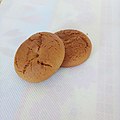Moustalevria
Moustalevria is a traditional dessert originating from Greece. It is a type of pudding made from grape must, a byproduct of winemaking. The dessert is typically prepared during the grape harvest season, which usually falls in the autumn months.
Ingredients and Preparation[edit]
The primary ingredient in moustalevria is grape must, which is freshly pressed grape juice that contains the skins, seeds, and stems of the fruit. The grape must is boiled until it reduces to a thick syrup, a process that can take several hours. Other ingredients such as sugar, flour, and cinnamon are then added to the syrup and the mixture is stirred until it thickens into a pudding-like consistency. The dessert is then allowed to cool and is often garnished with walnuts or sesame seeds before serving.
Cultural Significance[edit]
Moustalevria is deeply rooted in Greek culture and tradition. It is often prepared during the Feast of the Cross, a major feast day in the Eastern Orthodox Church that coincides with the grape harvest. The dessert is also associated with the ancient Greek festival of Trygetes, which was dedicated to Dionysus, the god of wine and grape harvest.
Nutritional Value[edit]
As a dessert made primarily from grape must, moustalevria is rich in antioxidants and other beneficial compounds found in grapes. However, it is also high in sugar and should be consumed in moderation.
See Also[edit]
This Greece-food related article is a stub. You can help WikiMD by expanding it.
Moustalevria[edit]
-
Moustalevria
Ad. Transform your life with W8MD's Budget GLP-1 injections from $75


W8MD offers a medical weight loss program to lose weight in Philadelphia. Our physician-supervised medical weight loss provides:
- Weight loss injections in NYC (generic and brand names):
- Zepbound / Mounjaro, Wegovy / Ozempic, Saxenda
- Most insurances accepted or discounted self-pay rates. We will obtain insurance prior authorizations if needed.
- Generic GLP1 weight loss injections from $75 for the starting dose.
- Also offer prescription weight loss medications including Phentermine, Qsymia, Diethylpropion, Contrave etc.
NYC weight loss doctor appointmentsNYC weight loss doctor appointments
Start your NYC weight loss journey today at our NYC medical weight loss and Philadelphia medical weight loss clinics.
- Call 718-946-5500 to lose weight in NYC or for medical weight loss in Philadelphia 215-676-2334.
- Tags:NYC medical weight loss, Philadelphia lose weight Zepbound NYC, Budget GLP1 weight loss injections, Wegovy Philadelphia, Wegovy NYC, Philadelphia medical weight loss, Brookly weight loss and Wegovy NYC
|
WikiMD's Wellness Encyclopedia |
| Let Food Be Thy Medicine Medicine Thy Food - Hippocrates |
Medical Disclaimer: WikiMD is not a substitute for professional medical advice. The information on WikiMD is provided as an information resource only, may be incorrect, outdated or misleading, and is not to be used or relied on for any diagnostic or treatment purposes. Please consult your health care provider before making any healthcare decisions or for guidance about a specific medical condition. WikiMD expressly disclaims responsibility, and shall have no liability, for any damages, loss, injury, or liability whatsoever suffered as a result of your reliance on the information contained in this site. By visiting this site you agree to the foregoing terms and conditions, which may from time to time be changed or supplemented by WikiMD. If you do not agree to the foregoing terms and conditions, you should not enter or use this site. See full disclaimer.
Credits:Most images are courtesy of Wikimedia commons, and templates, categories Wikipedia, licensed under CC BY SA or similar.
Translate this page: - East Asian
中文,
日本,
한국어,
South Asian
हिन्दी,
தமிழ்,
తెలుగు,
Urdu,
ಕನ್ನಡ,
Southeast Asian
Indonesian,
Vietnamese,
Thai,
မြန်မာဘာသာ,
বাংলা
European
español,
Deutsch,
français,
Greek,
português do Brasil,
polski,
română,
русский,
Nederlands,
norsk,
svenska,
suomi,
Italian
Middle Eastern & African
عربى,
Turkish,
Persian,
Hebrew,
Afrikaans,
isiZulu,
Kiswahili,
Other
Bulgarian,
Hungarian,
Czech,
Swedish,
മലയാളം,
मराठी,
ਪੰਜਾਬੀ,
ગુજરાતી,
Portuguese,
Ukrainian


